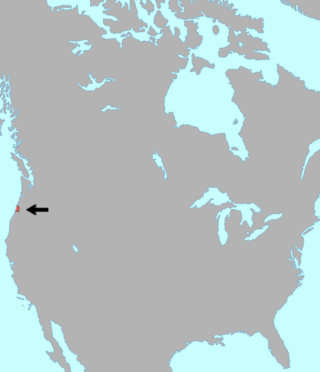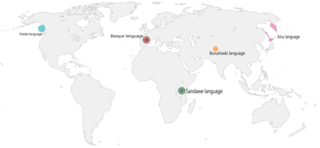
A language isolate is a language that has no demonstrable genetic relationship with another language. Basque in Europe, Ainu in Asia, Sandawe in Africa, Haida and Zuni in North America, Kanoê in South America, and Tiwi in Australia are all examples of language isolates. The exact number of language isolates is yet unknown due to insufficient data on several languages.

Penutian is a proposed grouping of language families that includes many Native American languages of western North America, predominantly spoken at one time in British Columbia, Washington, Oregon, and California. The existence of a Penutian stock or phylum has been the subject of debate among specialists. Even the unity of some of its component families has been disputed. Some of the problems in the comparative study of languages within the phylum are the result of their early extinction and limited documentation.
Oregon Penutian is a hypothetical language family in the Penutian language phylum comprising languages spoken at one time by several groups of Native Americans in present-day western Oregon and western Washington in the United States. Various languages in the family are divided by dialects that are in most cases identical to the various identified tribal bands in the region.

The Chinookan languages were a small family of languages spoken in Oregon and Washington along the Columbia River by Chinook peoples. Although the last known native speaker of any Chinookan language died in 2012, the 2009-2013 American Community Survey found 270 self-identified speakers of Upper Chinook.
The Alsea are a Native American tribe of Western Oregon. They are, confederated with other Tribes on the Siletz Reservation, Oregon, and are members of the Confederated Tribes of Siletz.

The Coosan language family consists of two languages spoken along the southern Oregon coast. Both languages are now extinct.
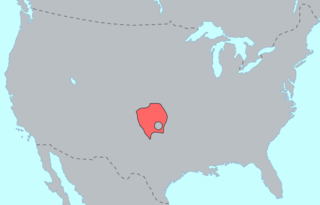
Kiowa or Cáuijògà/Cáuijò:gyà is a Tanoan language spoken by the Kiowa Tribe of Oklahoma in primarily Caddo, Kiowa, and Comanche counties. The Kiowa tribal center is located in Carnegie. Like most North American indigenous languages, Kiowa is an endangered language.

Yokuts, formerly known as Mariposa, is an endangered language spoken in the interior of Northern and Central California in and around the San Joaquin Valley by the Yokuts people. The speakers of Yokuts were severely affected by disease, missionaries, and the Gold Rush. While descendants of Yokuts speakers currently number in the thousands, all constituent dialects except for Valley Yokuts are now extinct.
Americanist phonetic notation, also known as the North American Phonetic Alphabet (NAPA), the Americanist Phonetic Alphabet or the American Phonetic Alphabet (APA), is a system of phonetic notation originally developed by European and American anthropologists and language scientists for the phonetic and phonemic transcription of indigenous languages of the Americas and for languages of Europe. It is still commonly used by linguists working on, among others, Slavic, Uralic, Semitic languages and for the languages of the Caucasus, of India, and of much of Africa; however, Uralists commonly use a variant known as the Uralic Phonetic Alphabet.
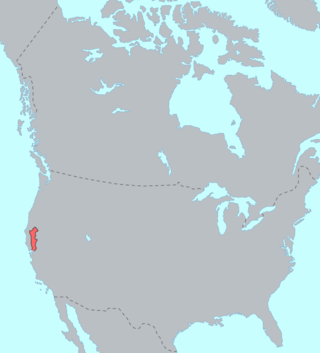
Wintuan is a family of languages spoken in the Sacramento Valley of central Northern California.

Kalapuyan is a small extinct language family that was spoken in the Willamette Valley of Western Oregon, United States. It consists of three languages.

The Tsimshianic languages are a family of languages spoken in northwestern British Columbia and in Southeast Alaska on Annette Island and Ketchikan. All Tsimshianic languages are endangered, some with only around 400 speakers. Only around 2,170 people of the ethnic Tsimshian population in Canada still speak a Tsimshian language; about 50 of the 1,300 Tsimshian people living in Alaska still speak Coast Tsimshian. Tsimshianic languages are considered by most linguists to be an independent language family, with four main languages: Coast Tsimshian, Southern Tsimshian, Nisg̱a’a, and Gitksan.
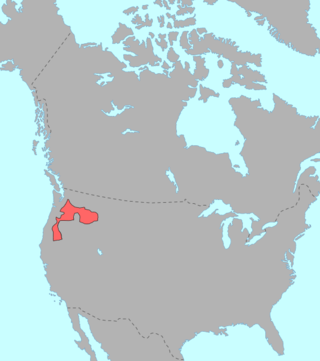
Nez Perce, also spelled Nez Percé or called nimipuutímt, is a Sahaptian language related to the several dialects of Sahaptin. Nez Perce comes from the French phrase nez percé, "pierced nose"; however, Nez Perce, who call themselves nimiipuu, meaning "the people", did not pierce their noses. This misnomer may have occurred as a result of confusion on the part of the French, as it was surrounding tribes who did so.

Maiduan is a small endangered language family of northeastern California.

Takelma is the name of the language that was spoken by the Latgawa and Takelma peoples and the Cow Creek band of Upper Umpqua, in Oregon, USA. The language was extensively described by the German-American linguist Edward Sapir in his graduate thesis, The Takelma Language of Southwestern Oregon (1912). Sapir’s grammar together with his Takelma Texts (1909) are the main sources of information on the language. Both are based on work carried out in 1906 with language consultant Frances Johnson, who lived on to become the last surviving fluent speaker. In 1934, with her death at the age of 99, the language became extinct. An English-Takelma dictionary is currently being created on the basis of printed sources with the aim of reviving the language.
Sahaptin or Shahaptin, endonym Ichishkin, is one of the two-language Sahaptian branch of the Plateau Penutian family spoken in a section of the northwestern plateau along the Columbia River and its tributaries in southern Washington, northern Oregon, and southwestern Idaho, in the United States; the other language is Nez Perce or Niimi'ipuutímt.

Siuslaw was the language of the Siuslaw people and Lower Umpqua (Kuitsh) people of Oregon. It is also known as Lower Umpqua. The Siuslaw language had two dialects: Siuslaw proper (Šaayušƛa) and Lower Umpqua (Quuiič).
The phonology of the Zuni language as spoken in the southwestern United States is described here. Phonology is a branch of linguistics that studies how languages or dialects systematically organize their sounds.
The Coast Oregon Penutian languages are a proposed family of three small languages or language clusters on the Oregon Coast that has moderate support. Although much of their similarity is demonstrably due to language contact, linguists such as Scott DeLancey believe they may be genealogically related at a greater time depth. They are part of the much more hypothetical Penutian proposal.
The Takelma–Kalapuyan languages are a proposed small language family that comprises the Kalapuyan languages and Takelma, which were formerly spoken in the Willamette Valley and the Rogue Valley in Oregon.
